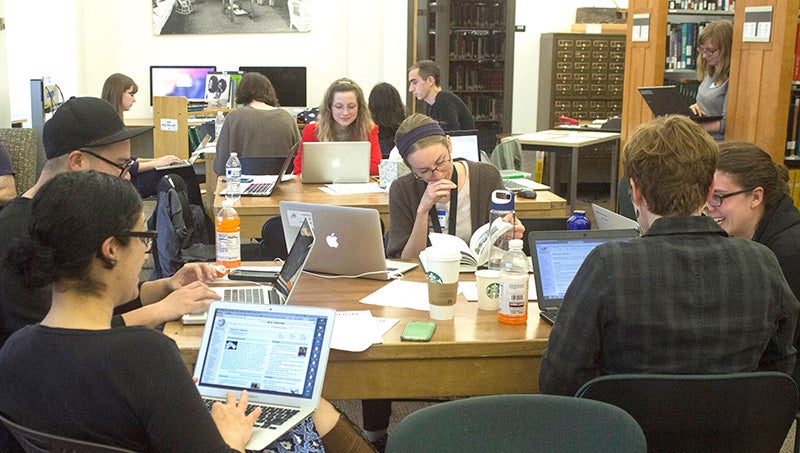Wikipedia is one of the most popular go-to sites for research and fact-checking, but the site suffers from some serious male bias.
A 2011 study from the Wikimedia Foundation found that only 9 percent of Wikipedia’s editors, and fewer than 13 percent of its writers, are female.
The disparity means that since the site crowd-sources its content, men write almost all of the nearly five million articles. Several editing sessions (deemed “edit-a-thons”) have taken place around the country to counter the stark gender imbalance and to increase the visibility of women artists on Wikipedia.
University of Oregon’s Art+Feminism Wikipedia edit-a-thon took place on Saturday, March 5, when volunteer editors filled the third floor of the A&AA library to change the way women are represented on the site.
“It was a great turnout from both the community and the university,” said art Associate Professor Tannaz Farsi, one of the event’s organizers between the Department of Art and UO Libraries.
“I’m happy to see men are here, too,” added Eugene resident and amateur Wiki editor Vicki Amorose.

Above: Students, faculty members, and others join A&AA librarians and professors during the Art+Feminism Wikipedia edit-a-thon on campus recently. The goal was to create and expand the visibility of women artists on Wikipedia, where 90 percent of editors are male. Photo by Emerson Malone.
During the editing, a whiteboard was filled with the various artists’ Wiki pages and a corresponding checkmark etched in beside it when a final article was submitted for approval.
Amorose focused on Portland-based artist Wendy Red Star, who contributed to an exhibit in the Smithsonian Museum in 2014, but her Wiki article failed to mention that achievement.
“It’s really fun when you find big things like that,” says Amorose. She noted that the female-based articles are often thinly written, while the pages about men are more embellished and researched.
“It’s very similar to the way that history is written by the victors,” says Amorose. “You do not hear the voices of the excluded. Certainly it affects the content of Wikipedia when 90 percent of its editors are male.”
The UO event’s meet-up page on Wikipedia offers numerous articles—including many Eugene-based artists and UO faculty members—which are up for grabs for anyone to claim and edit.
Farsi included the Wiki articles for Iranian artists Parastou Forouhar, Shirazeh Houshiary, and Sara Rahbar.
“Narrating their accomplishments and documenting their impact is a means of contributing to my field,” said Farsi. “To be part of the culture of adding knowledge goes hand-in-hand with what we do at the university.”

Above: Linda Long, manuscripts librarian, and Farhad Bahram, adjunct instructor in A&AA, update Wiki entries during the edit-a-thon. Bahram also was translating pages into Farsi “because the idea of feminism in Iran is new. The new generation is paying attention to it,” he said. “It’s becoming more practical in other areas, in political science and art. It’s something that could be so resourceful for a young Iranian activist right now.” Photo by Emerson Malone.
Farhad Bahram, an adjunct instructor in the Department of Art and MFA photography ’15 graduate, was updating Forouhar’s Wiki page.
“[Forouhar] talks about the change of identity and the contemporary political scene in Iran,” said Bahram of the installation-based artist.
Following these edits, Bahram planned to translate some of these English-language Wiki articles into Farsi.
“The reason I’m translating all these into Farsi is because the idea of feminism in Iran is new. The new generation is paying attention to it,” he said. “It’s becoming more practical in other areas, in political science and art. It’s something that could be so resourceful for a young Iranian activist right now.”
Eugene resident Mary Brau and member of Wikipedia Project Oregon, a statewide collective of volunteer editors, led regular tutorial sessions on how to create Wiki editor accounts, the anatomy of a Wiki page, and how to edit one.
She recommended that beginner editors use the Visual Editor, a WYSIWYG interface (a user-friendly Wiki editor that stands for “What You See Is What You Get”) rather than the code-heavy, cryptic standard, which is a primary deterrent for amateur editors.
Brau pulled up Georgia O’Keefe’s Wiki page, which Brau says is sometimes the target of relentless trolling and editing sabotage.
The page’s editing history showed that one writer deleted sizeable chunks of O’Keefe’s biography. Brau said high schools have access to Wikipedia and some immature students can manipulate pages from the school’s IP address without using an account.
Brau also pointed to the article on “The Death of Freddie Gray” as one on which editors may project personal judgments that can distort the entry’s neutrality. Some editors included minute details of Gray’s extensive criminal background; others brought up negative information on the Baltimore police officers. This is known as “undue weight,” when subjective content is added that ruins a page’s neutrality.
Art+Feminism is an international campaign that aims to add to coverage of women artists, photographers, and filmmakers on Wikipedia through these edit-a-thon events, which began in Brooklyn in 2014. On this same Saturday, dozens of other edit-a-thons were simultaneously taking place in universities and art museums around the globe—including Tunis, Stockholm, New York, and San Francisco.
